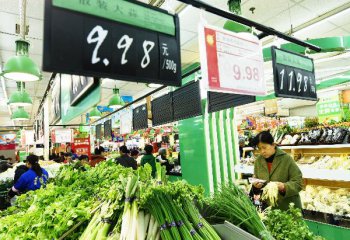
China’s consumer price index (CPI) and producer price index (PPI) recorded a growth of 2.0 percent and -1.4 percent respectively in 2016 and there wasn’t stagflation, which market was worried about at the beginning of last year. The market predicts that year-on-year growth of PPI will continue to pick up but won’t keep high growth for long time, while CPI will hike slightly. There won’t be too much pressure on inflation on the whole.
The Central Economic Working Conference proposed that government should keep monetary policy stable and neutral this year. Analysts think that this year’s policy should focus on curbing asset bubbles and preventing financial risks. Relatively tightened policy can curb inflation to some extent, so it is unnecessary to adopt extra monetary austerity measures like raising interest rate.
The CPI increased by 2.1 percent in last December, down by 0.2 percentage point from November, according to data released by National Bureau of Statistics (NBS) yesterday. It is the third consecutive month that growth rate of CPI has been above 2 percent.
For the whole of 2016, the CPI rose by 2 percent, with 0.6 percentage point higher than the growth in 2015 but well below the government's 3-percent annual target.
The global inflation tends to pick up in 2017 and prices of bulk commodities keep rebounding, the market seems to be concerned about China’s inflation issue again.
Liu Xuezhi, senior researcher with financial research center from Bank of Communications, told journalist of SSN that CPI is expected to climb mildly this year, may reach a peak at the middle of the year, and might grow by over 3 percent in certain months. In Liu’s opinion, the growth of CPI for the whole year of 2017 is likely to be higher than that in 2016 but won’t be more than 3 percent.
Prices of bulk commodities have been increasing since last year. This drove PPI to rebound and see positive growth in September of last year. PPI rose by 5.5 percent year on year last month. The growth rate was 2.2 percentage points higher than that in November and was the highest in more than five years, NBS data showed. It is the fourth consecutive month that growth rate of PPI has experienced positive year-on-year growth. .
Factors including the exchange rate of the Chinese yuan and rising prices of imported bulk commodities led to continuous rises in the PPI, NBS senior statistician Sheng Guoqing said, adding that market demand also saw steady recovery thanks to the ongoing industrial overhaul.
The PPI for the whole year dropped by 1.4 percent, recovering by 3.8 percentage points when compared with the decline in 2015. It is widely predicted that PPI growth will turn positive this year.
Liu indicated that as policy on real estate market is tightened and bond market experienced fluctuation, idled capital may flow into industrial product and consumption goods fields, which will boost relevant prices to surge quickly. It is forecasted that PPI may reach peak in the first quarter but remain steady later. PPI is likely to move up by about 5.5 percent in 2017.
However, Liu viewed that macro-economy develops slowly but steadily. It is difficult for economic status to back up commodity prices to surge remarkably. PPI’s conduction on CPI weakens. Therefore, there won’t be too much pressure on inflation on the whole.
As for the future policy trend, Zhang Jun, Chinese economist from Morgan Stanley Huaxin Securities Co., Ltd., said to the journalist of SSN that the current inflation is not threatening yet. To keep monetary policy of central bank neutral this year is to prevent asset price bubbles and lower financial risks. Relatively tightened policy can curb inflation to some extent, so it is unnecessary to adopt extra monetary austerity measures like raising interest rate.
Translated by Vanessa Chen





















Latest comments